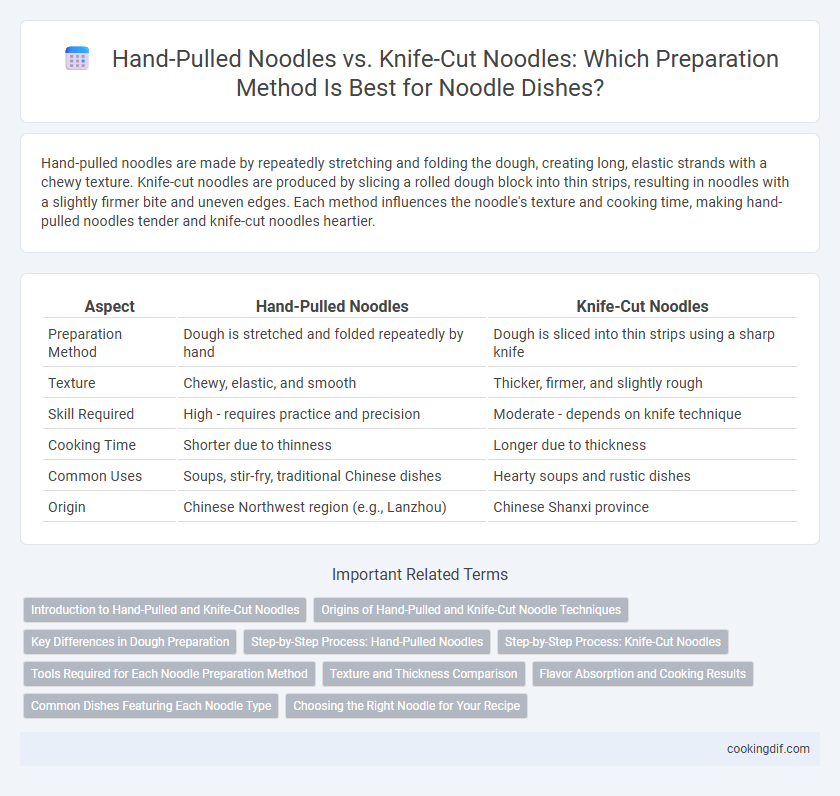Hand-pulled noodles are made by repeatedly stretching and folding the dough, creating long, elastic strands with a chewy texture. Knife-cut noodles are produced by slicing a rolled dough block into thin strips, resulting in noodles with a slightly firmer bite and uneven edges. Each method influences the noodle's texture and cooking time, making hand-pulled noodles tender and knife-cut noodles heartier.
Table of Comparison
| Aspect | Hand-Pulled Noodles | Knife-Cut Noodles |
|---|---|---|
| Preparation Method | Dough is stretched and folded repeatedly by hand | Dough is sliced into thin strips using a sharp knife |
| Texture | Chewy, elastic, and smooth | Thicker, firmer, and slightly rough |
| Skill Required | High - requires practice and precision | Moderate - depends on knife technique |
| Cooking Time | Shorter due to thinness | Longer due to thickness |
| Common Uses | Soups, stir-fry, traditional Chinese dishes | Hearty soups and rustic dishes |
| Origin | Chinese Northwest region (e.g., Lanzhou) | Chinese Shanxi province |
Introduction to Hand-Pulled and Knife-Cut Noodles
Hand-pulled noodles are crafted by repeatedly stretching and folding dough to create thin, elastic strands, emphasizing manual skill and texture. Knife-cut noodles are produced by slicing a firm dough block directly into boiling water, resulting in thicker, uneven strips with a chewy bite. Both methods highlight distinct cultural techniques that influence the noodle's texture, cooking time, and mouthfeel in traditional Asian cuisine.
Origins of Hand-Pulled and Knife-Cut Noodle Techniques
Hand-pulled noodles originate from China's Lamian tradition, where dough is skillfully stretched and folded repeatedly by hand to create thin, elastic strands. Knife-cut noodles, known as Dao Xiao Mian, come from northern China and are prepared by shaving small strips directly from a block of dough into boiling water. Both techniques reflect regional culinary heritage and emphasize distinct textures through differing preparation methods.
Key Differences in Dough Preparation
Hand-pulled noodles require a highly elastic dough made with high-protein flour and precise hydration to allow stretching without breaking, while knife-cut noodles use a stiffer, less elastic dough that holds shape during slicing. The hand-pulling technique involves repeated stretching and folding to develop gluten structure, enhancing chewiness and texture. Conversely, knife-cut noodles rely on firm dough that can be sliced thinly with a sharp blade, resulting in noodles with a slightly denser bite.
Step-by-Step Process: Hand-Pulled Noodles
Hand-pulled noodles require a meticulous step-by-step process involving dough preparation, repeated stretching, folding, and twisting to achieve the desired thinness and elasticity. The dough, made from high-gluten flour and water, is rested to develop gluten, enhancing its stretchability during the pulling phase. Skilled chefs perform multiple cycles of pulling and folding, carefully controlling the noodle thickness to maintain a uniform texture distinct from the rougher surface of knife-cut noodles.
Step-by-Step Process: Knife-Cut Noodles
Knife-cut noodles begin with a dough made from high-protein wheat flour and water, kneaded until smooth and elastic. The dough is rolled out into a thick sheet and then held firmly as a sharp knife quickly slices thin strips directly into boiling water. This rapid cutting and cooking process results in noodles with irregular edges, providing a unique texture that is chewier and absorbs broth more effectively than hand-pulled varieties.
Tools Required for Each Noodle Preparation Method
Hand-pulled noodles require a clean, flat surface and enough space for stretching the dough repeatedly to achieve the desired thinness, using only the cook's hands as the primary tool. Knife-cut noodles rely on a sharp, sturdy knife and a solid cutting board to slice rolled dough into uniform strips quickly and efficiently. The preparation method significantly influences the texture and appearance of the noodles, with hand-pulled approaches demanding more manual dexterity and knife-cut requiring precise cutting tools.
Texture and Thickness Comparison
Hand-pulled noodles exhibit a chewy, elastic texture with uniform thickness achieved through repeated stretching, resulting in long, thin strands that hold sauce well. Knife-cut noodles feature a denser bite and varied thickness, as each slice creates broad, rustic ribbons with slight irregularities enhancing their hearty mouthfeel. The preparation method directly influences noodle structure, where hand-pulling favors delicate, springy strands, while knife-cutting produces thick, robust noodles with a satisfying firmness.
Flavor Absorption and Cooking Results
Hand-pulled noodles feature a porous texture that enhances flavor absorption, allowing broths and sauces to cling tightly, resulting in richer taste profiles. Knife-cut noodles tend to have a denser, chewier bite with a smoother surface, which slightly limits their ability to soak up flavors but creates a satisfying firmness when cooked. The preparation method directly impacts broth infusion and mouthfeel, making hand-pulled noodles ideal for soups and knife-cut noodles preferred in stir-fried dishes.
Common Dishes Featuring Each Noodle Type
Hand-pulled noodles, prized for their chewy texture, are commonly featured in dishes like Lanzhou beef noodle soup and biang biang noodles, where the long, elastic strands absorb rich broths and sauces effectively. Knife-cut noodles, characterized by their thick, irregular shapes, are typically found in hearty stews such as Shanxi knife-cut noodle soup, showcasing their ability to hold up well in robust, flavorful broths. Both noodle types highlight regional Chinese culinary traditions, emphasizing texture and flavor compatibility in signature dishes.
Choosing the Right Noodle for Your Recipe
Hand-pulled noodles offer a chewy texture and elasticity ideal for soups and stir-fries, while knife-cut noodles provide a thicker, heartier bite suited for robust sauces and broths. Selecting the right noodle depends on the desired eating experience and cooking technique, with hand-pulled noodles requiring skillful stretching and knife-cut noodles involving slicing dough into uniform strips. Understanding these preparation methods ensures optimal texture and flavor integration in your dish.
Hand-pulled noodles vs knife-cut noodles for preparation method Infographic

 cookingdif.com
cookingdif.com